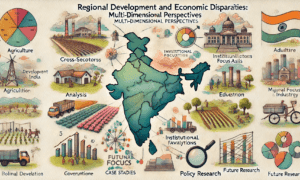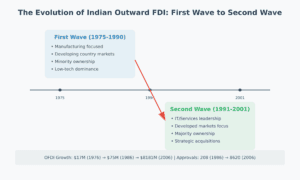The Hidden Geography of Export Success What makes some Indian small businesses successful exporters while others struggle to go global? The answer might be right under our feet – quite literally. Groundbreaking research by Pradhan and Das reveals that where a business is located within India can dramatically impact its ability to reach international markets.
Your Address Matters More Than You Think Imagine your small business as a rocket trying to launch into international markets. Just as a rocket needs the right launchpad, your business needs the right regional foundation. The study found several critical “launch factors”:
The Perfect Launch Environment
- A Thriving Local Market
- Businesses in states with larger, growing economies are more likely to export successfully
- Higher local income levels help companies develop products that appeal globally
- Strong domestic demand provides the foundation for international expansion
- The Knowledge Advantage
- Regions with more patents and R&D activity create “innovation spillovers”
- Being surrounded by technology-intensive industries boosts export potential
- Access to research facilities helps even small firms innovate
- The Infrastructure Edge
- Good roads significantly boost export performance
- Access to ports is crucial for international shipping
- Available business financing helps firms take the export leap
The Foreign Investment Puzzle Here’s where things get interesting. The research uncovered a surprising pattern with foreign investment:
- Direct competition with foreign companies often reduces SME exports
- However, SMEs with foreign shareholders tend to export more successfully
- The key is partnering with foreign firms rather than just competing against them
Size Isn’t Everything While larger SMEs generally export more, the study offers hope for smaller players:
- Younger firms often outperform older ones in exports
- Location advantages can help level the playing field
- Even small firms can succeed with the right regional support
Practical Takeaways
For Business Owners:
- Consider regional advantages when choosing your location
- Look for areas with good export infrastructure
- Seek foreign partnerships rather than just competing with foreign firms
- Tap into local R&D networks and knowledge resources
For Policymakers:
- Focus on developing export-enabling infrastructure
- Create programs linking SMEs with research facilities
- Provide market intelligence about international opportunities
- Offer extra support to smaller enterprises
The Path Forward The research suggests that India’s SME export success isn’t just about individual business capabilities – it’s about creating powerful regional ecosystems. By understanding and leveraging these regional advantages, both businesses and policymakers can help unlock the enormous export potential of India’s small business sector.
Academic Abstract:
This study analyses regional determinants of export performance of small and medium enterprises (SMEs) in India. The export determinant analysis brings out the significance of certain key physical and economic infrastructure for SMEs, particularly access to roads, ports and loan finance. Local market conditions, namely the size, growth and per capita income of the host states also favourably affect SME export activities. State’s stock of technological knowledge also encourages SME exporting. While direct competition with foreign players tends to dampen exporting by SMEs, foreign shareholding participation in SMEs allows affiliated firms to achieve higher level of exports. Apart from improving the key business support infrastructure, export orientation of SMEs could be enhanced by networking them with R&D facilities and providing them easier access to information about overseas markets. Relatively smaller enterprises need greater support as they are disadvantaged by their size.
Learn More:
- Full citation: Pradhan, Jaya Prakash and Keshab Das (2013), ‘Exporting by Indian Small and Medium Enterprises: Role of Regional Technological Knowledge, Agglomeration, and Foreign Direct Investment. Innovation and Development’, 3(2), pp. 239-257.
Learn More:





































